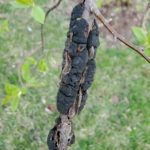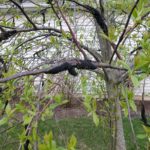Black knot, caused by the fungus Apiosporina morbosa, is a recurring problem on Prunus species. Most Indiana fruit growers, both professional and amateur, have at one time or another observed the black, knot-like warty growths (Fig. 1) that often occur on the woody parts of plum and cherry trees. This fungal disease is one of the most common stone fruit problems in America. It infects both wild and cultivated forms of cherries and plums, and occasionally peaches; however, in general, plums are more severely attacked. The disease occurs routinely on wild cherry trees. A small swelling first appears on a twig or branch of a susceptible tree. Newly formed “knots” are greenish and soft but become hard and black with age. The growth enlarges every season, weakening the tree, and eventually it may completely girdle the infected branch. Trees severely affected by the disease are difficult to save (Fig 2).
- Figure 1
- Figure 2
Management starts with selecting only disease-free nursery stock, avoiding trees with visible knots or abnormal swellings on the twigs and branches. In its early stages the symptoms appear as light brown swellings that later rupture the bark and turn darker. To control the problem on infected trees, prune out and burn (or bury) all infected wood in late winter or early spring before growth starts and as soon as new knots appear. Make cuts four to eight inches behind any obvious, black-knot swellings. Knots on the trunk or on large limbs can be carefully cut out with a knife and chisel, removing about an inch of healthy bark and woody tissue beyond any visible gall tissue, however if this kind of removal would cause major damage to the tree it may be best to just leave them alone. Trees with cankers on the main trunk will be weak and may break off in high winds. If practical, remove wild, neglected, or worthless plum and cherry trees nearby to reduce spread.
Fungicide applications may help but their effect is limited, especially if other sanitation control measures have not been used. Lime sulfur or chlorothalonil can be applied as a dormant spray in the early spring prior to bud swell. Sprays must be applied before existing galls begin to produce spores and should be applied every 2 weeks until the sporulation period ends. Always read and follow all label directions when using pesticides.
Additional Resources:

